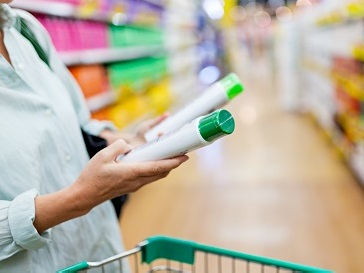Consumers who avoid products with harmful chemicals on the label have lower body burden
 Reading ingredient labels reduces exposures to many endocrine disruptors—but not all
Reading ingredient labels reduces exposures to many endocrine disruptors—but not all
Finding healthier products without harmful chemicals—shampoo free of parabens or fragrance-free deodorant— is not always easy. It often involves scouring ingredients on individual product labels in search of key words. But is it worth it? New research shows that paying close attention to what’s in the products you buy can pay off. In a study led by Silent Spring Institute, researchers found that consumers who avoided products containing specific endocrine disruptors had significantly lower levels of the chemicals in their bodies.
Endocrine disruptors are chemicals that are widely-used in personal care and household products. Scientists are concerned about the public’s exposure because the chemicals can interfere with the body’s hormones and lead to health problems such as reproductive disorders, thyroid disease, asthma, and cancers.
“That’s why expert scientific panels and medical societies recommend that people take steps to limit their exposures to these chemicals,” says lead author, Dr. Robin Dodson, an environmental exposure scientist at Silent Spring. “And, with the current pandemic, we see how diseases associated with environmental chemicals also make people more vulnerable to COVID-19—yet another reason to reduce exposures in the population.”
To assess the influence of different types of products on people’s exposures, Dodson and her team collected urine samples from 726 participants across the United States who signed up to join the Institute’s crowdsourced biomonitoring project. Participants mailed in their samples and researchers analyzed the samples for 10 common endocrine disruptors.
Participants also completed an online survey that asked questions about the products they use and whether they avoid ones with specific chemicals listed on the label.
Reporting September 30 in the International Journal of Hygiene and Environmental Health, the researchers found a large majority of participants (87%) were taking steps to avoid certain chemicals in products, and that overall participants had lower levels of parabens, BPA, triclosan, and benzophone-3 compared with the U.S. population. When the researchers compared participants with each other, they found:
- People who avoided products with parabens, triclosan, BPA, and fragrances were twice as likely to be in the group with the lowest body burden for all chemicals combined.
- Avoiding certain products and reading ingredient labels was most effective at reducing exposures to parabens, triclosan, and benzophenone-3.
- In contrast, people who tried to avoid products containing BPA had levels similar to those who did not avoid the chemical, which suggests there are other sources of BPA that consumers may not be aware of.
“This study not only helped us gain a better understanding of how product choices influence people’s exposures to endocrine disruptors, but it also provided us with an opportunity to educate consumers and empower them to make healthier choices,” says Dodson.
After their urine samples were analyzed, Silent Spring sent each participant a personalized digital report that compared their levels with the collective data from all participants as well as national data. The interactive report also contained information on the different chemicals, the associated health effects, where they’re found, and how to avoid them.
Participants were invited to download Silent Spring’s free mobile app Detox Me to learn more about reducing their exposures in their everyday environments, either through the products they choose or through simple changes in their daily behaviors.
However, as Dodson points out, some chemicals are hard to avoid because it’s unclear what products they’re in. For instance, some of the participants said they either avoided products with parabens or used few products overall, and yet they still had high levels of parabens in their bodies. “What this study shows us is that people can’t shop their way out of this problem,” she says. “This is about much more than consumer choice.”
Although requiring companies to be more transparent about the chemicals in their products through better labeling policies could help people further reduce their exposures, this still puts the onus on consumers. “Ultimately, encouraging companies to invest in safer alternatives and strengthening regulations to keep harmful chemicals out of products in the first place would be the most effective and equitable way to protect public health,” says Dodson.
Resources or References
Reference: Dodson, R.E., K. E. Boronow, H. Susmann, J.O. Udesky, K.M. Rodgers, D. Weller, M. Woudneh, J.G. Brody, R.A. Rudel. 2020. Consumer behavior and exposure to parabens, bisphenols, triclosan, dichlorophenols, and benzophenone-3: Results from a crowdsourced biomonitoring study. International Journal of Hygiene and Environmental Health. DOI: 10.1016/j.ijheh.2020.113624